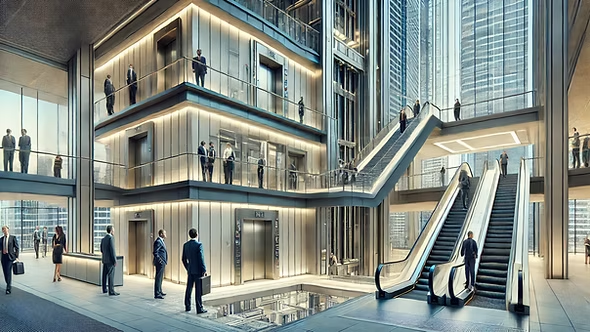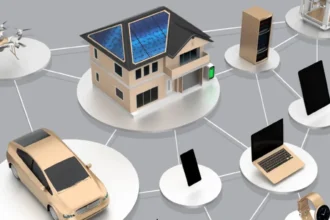In the world of modern construction and architecture, vertical growth has become the standard. From commercial office towers and luxury condominiums to expansive hospital complexes and hotels, buildings are reaching higher into the skyline than ever before. With this vertical expansion comes a critical challenge how do people move efficiently, safely, and reliably between floors?
This is where the role of a vertical transportation consultant becomes indispensable. These specialized professionals play a central role in the planning, design, implementation, and maintenance of elevator, escalator, and lift systems. Their expertise ensures that people can move seamlessly throughout the building, reducing wait times, energy use, and long-term operational costs.
In this blog post, we’ll break down the importance of vertical transportation consultants, when and why you need one, the advantages they bring to high-rise projects, and how they contribute to long-term safety and profitability.
What Is a Vertical Transportation Consultant?
A vertical transportation consultant is a trained professional who focuses on elevator and escalator systems within buildings. Their job is to ensure the optimal design, functionality, safety, and cost-effectiveness of these systems during every stage of a building’s lifecycle from initial planning and construction to long-term maintenance and modernization.
They work closely with architects, structural engineers, mechanical contractors, and property managers to provide expert advice on elevator types, capacities, speeds, placement, traffic flow, and technology integration.
Key Responsibilities of a Vertical Transportation Consultant
- System Design & Planning
Consultants determine the ideal number, type, and layout of elevators or escalators based on building use, expected traffic patterns, and floor count.
- Traffic Analysis
They analyze how people will move through the building and use simulation software to model elevator traffic during peak hours.
- Vendor Specification & Tendering
Consultants draft precise specifications for elevator systems and help clients compare bids from different manufacturers or service providers.
- Code Compliance & Safety
They ensure all systems meet local, national, and international safety codes, such as ASME A17.1/CSA B44 or EN 81.
- Modernization Strategies
For existing buildings, they assess aging systems and recommend upgrades that enhance performance, efficiency, and compliance.
- Maintenance Oversight
Vertical transportation consultants can monitor maintenance contracts, ensure SLAs are met, and perform third-party audits.
Why Vertical Transportation Systems Matter in High-Rise Buildings
Elevators and escalators aren’t just about convenience they’re essential to the functionality of tall structures. In buildings over five stories, stairs are no longer practical for daily use, and vertical transport becomes the primary mode of movement.
Here’s why their performance is crucial:
- Accessibility: They ensure the building is usable for everyone, including seniors and people with disabilities.
- Time Efficiency: Poorly designed systems cause delays, employee dissatisfaction, and productivity losses.
- Safety & Emergency Readiness: Elevators must be equipped to handle emergencies, such as fire service operation or earthquake shutdown protocols.
- Energy Consumption: Smart elevator systems can significantly reduce a building’s energy footprint, contributing to green building certifications like LEED.
Top Benefits of Hiring a Vertical Transportation Consultant
1. Informed System Design for High Efficiency
A consultant ensures that the elevator system matches the building’s purpose. A luxury hotel, for instance, needs different elevator speeds, interior finishes, and access control features than a medical facility.
Consultants use advanced modeling tools to simulate passenger flow and wait times. This prevents bottlenecks and ensures a smooth experience for all users, even during peak traffic hours like lunch breaks or shift changes.
2. Code Compliance and Safety Assurance
Elevator and escalator codes evolve regularly. Consultants stay updated with the latest safety and accessibility requirements. This ensures that new and modernized systems comply with:
- ADA (Americans with Disabilities Act)
- ASME A17.1 (Safety Code for Elevators and Escalators)
- Local fire codes
- International Building Code (IBC)
By following best practices and legal requirements, consultants help avoid costly fines, lawsuits, or insurance claim denials.
3. Cost Savings Over the Building Lifecycle
Hiring a consultant may seem like an added cost, but it saves money in the long run. Mistakes in elevator planning or installation are expensive to fix once a building is completed.
Consultants help reduce costs by:
- Selecting the most cost-effective, future-proof technology
- Avoiding overspending on unnecessary features
- Negotiating better maintenance and installation contracts
- Reducing long-term operational energy costs
4. Future-Proofing with Smart Technology
Smart building trends are revolutionizing how elevators operate. Touchless buttons, AI-powered dispatching, destination control systems, and IoT maintenance monitoring are quickly becoming industry standards.
Vertical transportation consultants integrate these technologies into the initial planning phase to ensure seamless upgrades as the building ages.
5. Modernization and Retrofitting Expertise
For older buildings, elevators might be outdated, slow, or non-compliant with current standards. A vertical transportation consultant conducts a full system audit and offers recommendations that might include:
- Control system upgrades
- New motors or drives
- Car modernization
- Energy-efficient lighting
- Updated safety components
This extends equipment lifespan, improves performance, and increases property value.
When Should You Hire a Vertical Transportation Consultant?
It’s never too early to bring a consultant into the process. Below are key stages where their involvement is most impactful:
| Project Stage | Why a Consultant Helps |
| Pre-Construction | Ensures space allocation and efficient design |
| Design Phase | Integrates elevator systems into architectural planning |
| Tender Phase | Provides objective bid evaluation and negotiation |
| Construction & Installation | Oversees vendor compliance and quality control |
| Post-Occupancy | Assesses performance and recommends adjustments |
| Modernization | Helps avoid full replacement with targeted upgrades |
Industries That Rely on Vertical Transportation Consultants
- Commercial Real Estate: Office towers need high-speed, high-capacity elevators with secure floor access and energy efficiency. To understand how elevator requirements differ by building type, check out our guide on Residential Elevators vs. Commercial Elevators: What is the Difference?
- Hospitality: Hotels require silent, aesthetically pleasing, and reliable elevators that improve guest experience.
- Healthcare: Hospitals need elevators that are fast, spacious, and code-compliant for beds, staff, and equipment.
- Retail: Shopping centers depend on escalators and elevators to keep foot traffic moving smoothly between floors.
- Education: Universities and campuses benefit from ADA-compliant vertical transportation that meets safety standards.
Common Mistakes When Elevators Are Not Professionally Designed
Many developers skip hiring a consultant to save on initial costs—only to face expensive setbacks. Here are the most common issues in buildings without expert consultation:
- Excessive Wait Times: Frustrates tenants and lowers building appeal.
- Undersized Systems: Can’t handle peak-hour traffic, causing delays.
- Overdesigned Systems: Wastes capital and increases maintenance expenses.
- Code Violations: Leads to fines or halts occupancy permits.
- Lack of Accessibility: Violates ADA and limits usage.
Key Technologies in Modern Vertical Transportation
Today’s vertical transport systems go beyond buttons and cables. Consultants often recommend or work with:
- Destination Dispatch Systems: Reduces wait and travel times by grouping passengers going to the same floor.
- Regenerative Drives: Capture and reuse energy from elevator movement.
- Remote Monitoring: Allows real-time diagnostics and predictive maintenance.
- Touchless Access Control: Essential in post-pandemic buildings for hygiene and convenience.
How to Choose the Right Vertical Transportation Consultant
Here’s what to look for when hiring:
Proven Track Record: Experience with similar building types or industries.
Vendor Neutrality: Unbiased advice with no commission from manufacturers.
Strong Communication: Ability to work closely with architects, engineers, and contractors.
Technology-Focused: Knowledge of the latest vertical transport innovations.
Audit Capability: Offers post-installation assessments and maintenance reviews.
A Smart Investment for Long-Term Success
A vertical transportation consultant is not just a project advisor they’re a long-term partner in your building’s success. From ensuring code compliance and optimal design to reducing long-term costs and incorporating future-ready technologies, their value is undeniable.
As urban landscapes continue to evolve, elevators and escalators are no longer just amenities they’re the core arteries of any modern building. By investing in expert consultation, building owners and developers gain not only peace of mind but a competitive edge in a high-stakes real estate market.

















